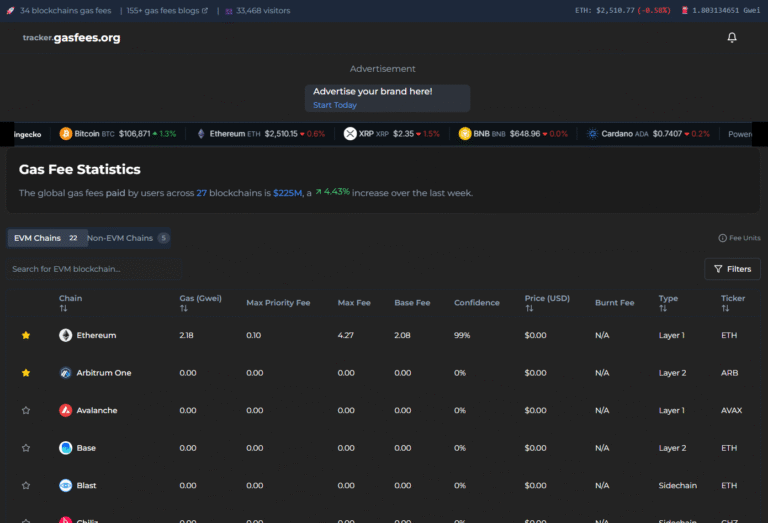
What Are Plasma Gas Fees?
Written By: Mr. GasMan
Beyond the Ethereum Mainnet:
Imagine Ethereum, the bustling metropolis of blockchain applications, teeming with activity. Transactions zip through the network, each carrying a tiny toll – the gas fee. While necessary for network security and ensuring miners are compensated, these fees can skyrocket during peak times, becoming a roadblock for users. To address this congestion, scaling solutions like Plasma emerge, offering alternative avenues for transactions to occur, easing the burden on the mainnet.
Enter the Sidechain Stage:
Think of Plasma as a bustling satellite city connected to Ethereum via a secure bridge. Here, transactions happen off-chain, away from the congested mainnet. Instead of paying hefty gas fees on the main Ethereum network, Plasma transactions incur significantly lower costs within their own ecosystem. This cost reduction opens doors for smaller transactions, micropayments, and even complex dApps that would otherwise be prohibitively expensive on the mainnet.
But How Do Plasma Gas Fees Work?
Unlike a flat tax system, Plasma employs a dynamic fee structure based on several factors, including:
- Transaction Complexity: More complex transactions require more computational resources, resulting in slightly higher fees.
- State Commitment: Plasma periodically records a snapshot of its state onto the Ethereum mainnet, ensuring security and immutability. This process incurs gas fees on the mainnet, which are ultimately shared among users within the Plasma sidechain.
- Operator Incentives: To incentivize validators to secure the network, Plasma rewards them with fees collected from transactions.
Beyond the Price Tag: Benefits of Plasma:
The reduced gas fees are just the tip of the iceberg. Plasma offers several other benefits:
- Scalability: With transactions happening off-chain, Plasma significantly increases the capacity of the Ethereum network, paving the way for widespread adoption.
- Security: Despite operating off-chain, Plasma inherits its security from the Ethereum mainnet through the secure bridge and periodic state commitments.
- Privacy: Certain Plasma implementations offer enhanced privacy features for users seeking greater anonymity in their transactions.
The Evolving Landscape of Plasma:
While Plasma holds immense potential, it’s still under development. Different Plasma implementations exist, each with its own unique features and fee structures. Some popular examples include:
- Optimistic Plasma: Focused on fast, fraud-proof transactions with low fees.
- State Plasma: Offers stronger data availability guarantees but may have slightly higher fees.
- Plasma Cash: Designed for efficient asset transfers with minimal fees.
Gas Fees Demystified:
Understanding Plasma gas fees is a crucial step in navigating the evolving landscape of blockchain scaling solutions. While the exact fees vary depending on the implementation and network conditions, their significantly lower cost compared to the mainnet opens exciting possibilities for increased accessibility and innovation within the blockchain ecosystem.
Looking Ahead:
As Plasma development continues, we can expect further optimization and refinement of its fee structure. With a keen focus on user experience and affordability, Plasma holds the potential to revolutionize the way we interact with and utilize blockchain technology, ushering in a new era of accessible and cost-effective transactions for all.
1. Polygon: The Speed Demon of Scalability
Polygon, the reigning champion of sidechains, leverages Plasma alongside other scaling techniques like zk-proofs and optimistic rollups to bring lightning-fast transactions to Ethereum. Imagine a bustling highway transformed into a network of smooth side roads, all seamlessly connected to the main Ethereum artery. This translates to cheaper fees, quicker confirmations, and ultimately, a more delightful user experience.
2. OMG Network: Secure Transactions, Scaled Up
OMG network prioritizes safety and scalability like a cautious adventurer. It harnesses Plasma’s power to bundle transactions and process them off-chain, only settling final confirmations on the Ethereum mainnet. This not only saves gas but also offers robust security, making it ideal for building reliable and scalable payment applications on Ethereum.
3. Gluon: The Trading Oasis in the Scalability Desert
For the fast-paced world of crypto trading, Gluon offers a refreshing oasis. Imagine a high-speed trading platform fueled by Plasma, yet non-custodial and secure. That’s Gluon! It combines Plasma’s efficiency with features like margin trading and exhaustive fraud proofs, giving traders the speed and peace of mind they crave, all without sacrificing decentralization or privacy.
4. Loom Network: Tailor-Made Blockchains for Bespoke Needs
Unlike a one-size-fits-all approach, Loom Network empowers developers to craft their own sidechains, each tailored to their specific application. Think of it as a blockchain Lego set! Using Plasma as the foundation, developers can build custom networks with distinct rules and features, optimizing performance and gas costs for their individual needs.
These are just a glimpse into the vibrant Plasma landscape. With each sidechain offering unique advantages, the possibilities for scaling and innovation are boundless. From speedy payments to secure trading and bespoke dApps, Plasma paves the way for a more diverse and accessible blockchain future.
Share this blog:
Trezor Safe 5
Recent Gas Fees Post
Why Use GasFees.org? 🛠️
📊 Real-Time Data: Get accurate gas fee updates anytime.
🌍 All Blockchains: Layer 1 and Layer 2 covered in one place.
💸 Save Money: Optimize transactions with our insights.
🔍 Easy to Use: Designed for beginners and experts alike.

 Real-Time Gas Fees Tracker!
Real-Time Gas Fees Tracker! 









